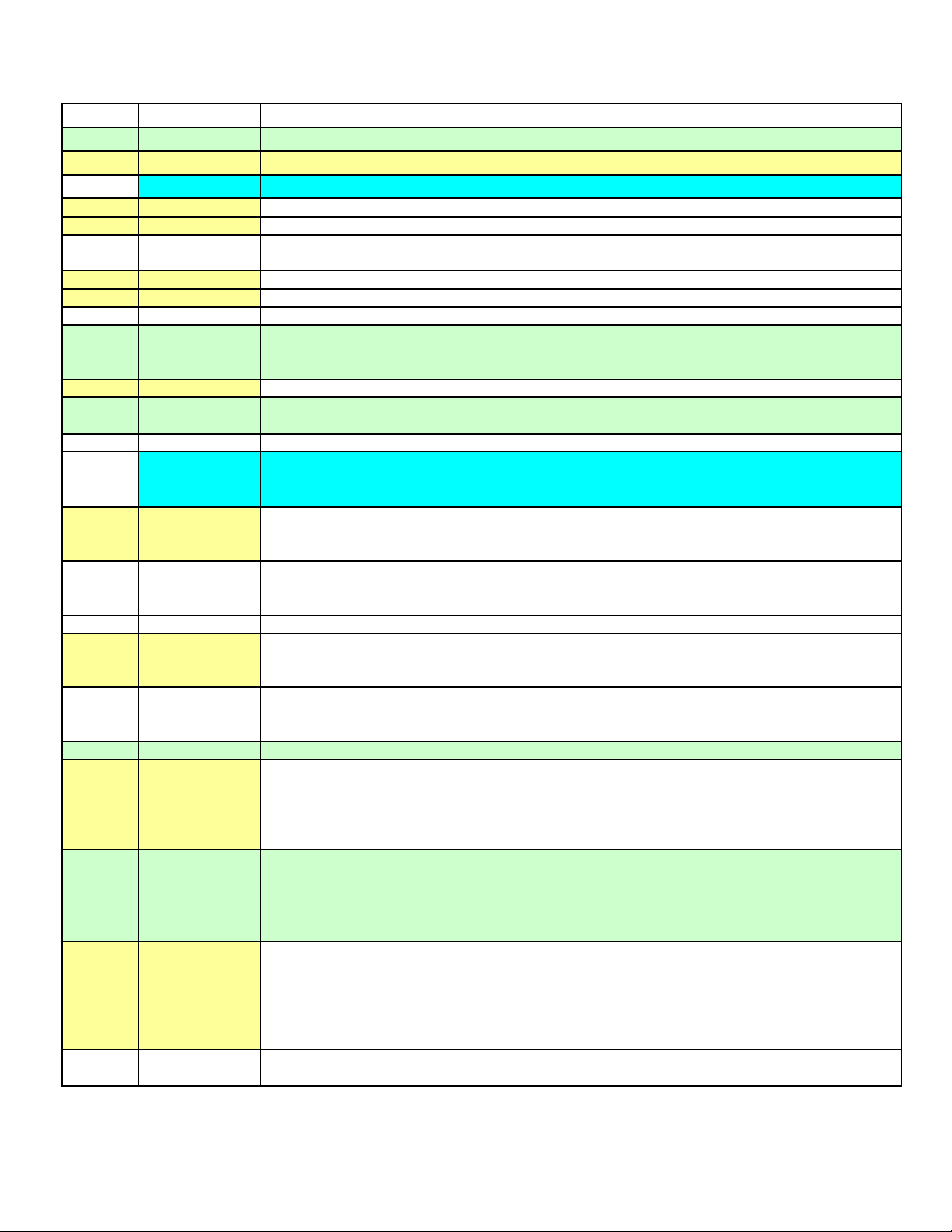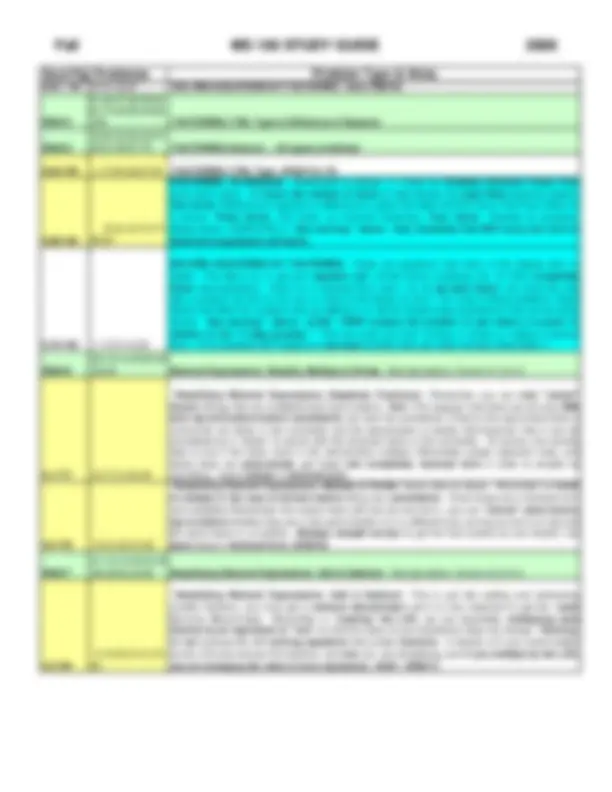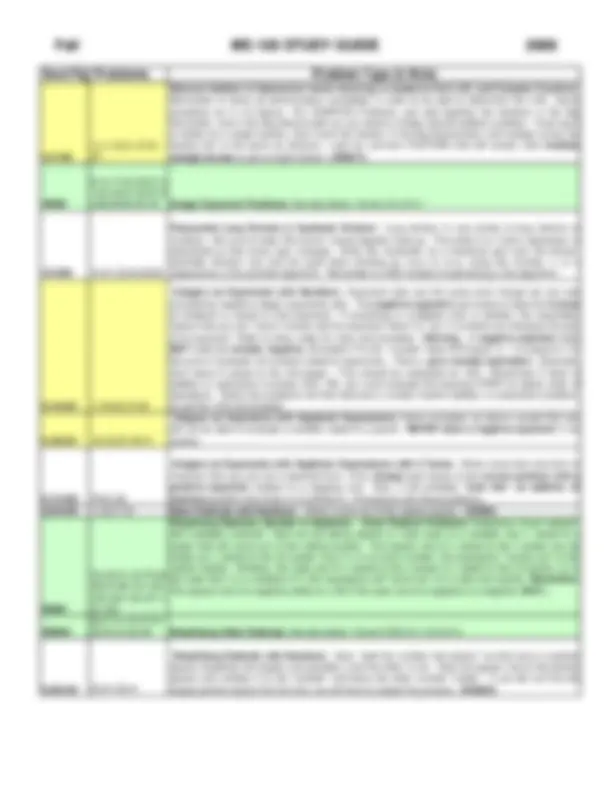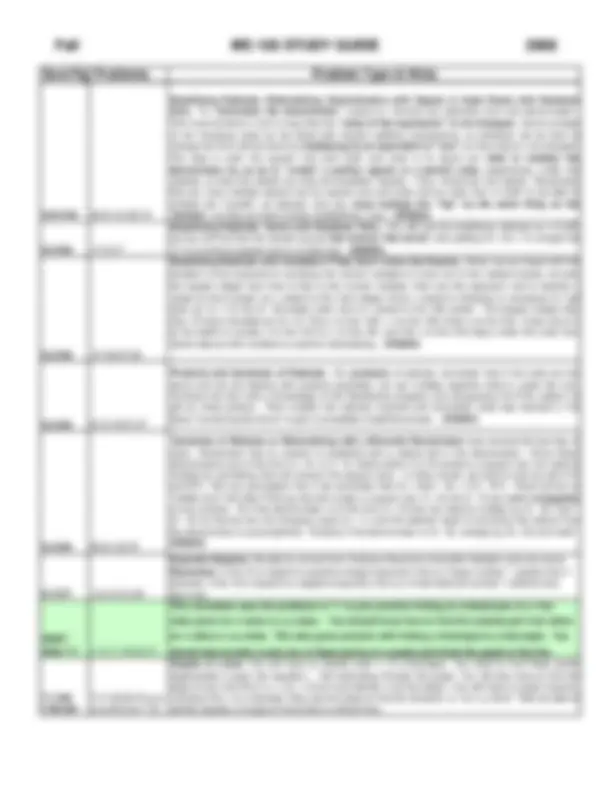





Study with the several resources on Docsity

Earn points by helping other students or get them with a premium plan


Prepare for your exams
Study with the several resources on Docsity

Earn points to download
Earn points by helping other students or get them with a premium plan
Community
Ask the community for help and clear up your study doubts
Discover the best universities in your country according to Docsity users
Free resources
Download our free guides on studying techniques, anxiety management strategies, and thesis advice from Docsity tutors
A study guide for algebra, covering topics such as order of operations, solving equations with integers, fractions, decimals, and symbolic expressions, and graphing lines. It includes various worksheets and problem types with hints.
Typology: Study notes
1 / 6

This page cannot be seen from the preview
Don't miss anything!




1.1/ 11 55,59,67 Integer Order of Operations 1.2/ 20 41,49,61,69 Order of Operations
WS#
6,114 Order of Operations with Arithmetic 1.3/ 29 27,29,41,45 Order of Operations with Exponents 1.4/ 37 15,21,41 Simple Algebraic Expressions, Evaluating with Substitution T1/38 65,69,75,77 English Phrases Translated into Algebraic Expressions
Solving simple linear equations with integers, fractions, decimals & symbolic. Covers most of 2.1 - 2.4. See Hints for 2.2A, 2.3A, 2.4A & B 2.1A/ 51 11,27,39,49 Solve Linear (1st degree) Equations with Integers (WS#3)
WS#
Simple Number Type Word Problems. Answers include the necessary equation & final answer. Other word problems noted below from the book. 2.1B/51 51,53,55,57 Word Problems: "Number Type"
When multiplying by LCD in a fraction equation or by the correct power of 10 in a decimal equation , remember to multiply each TERM of both sides of the equation by the necessary number so that you can correctly "cancel" denominator or shift decimal point.
Solve 1st Degree Equations with Fractions: Remember you can multiply both sides of the equation by the LCD to "remove the fractions" from the equation. The safest way is to multiply each term by the LCD. (WS#3)
2.2B&C/ 60 41,45,
Word Problems: "Number Type" with Fractions. Remember that Fractions "Never stand alone" IF the wording is a "fraction of …..". For example one-half OF a number or variable indicates to multiply the number or the variable by 1/2. 2.2D/ 60 43,47,55 Word Problems: "Geometry" with Fractions
Solve Decimal Equations: Same idea as the fractional equations... You can multiply each term by the correct multiple of 10 to "remove the decimal". Be careful to "add zero's" when needed in this process. (WS#3)
Word Problems: Percents & Decimals. As with "fraction of" a number for 2.2B&C, if dealing with a "percent of" something, it indicates to multiply. In this case, you must FIRST change the % to a decimal by shifting the decimal 2 places to the left, then multiply in decimal form. WS#20 5,6,11,20,21,24^ Word Problems: Percents, Decimals, including Mixture Problems
Symbolic Linear Equations: Solving for One Variable "in Terms of" or by Substitution: Solve for the unknown cited and treat the other unknowns "like they were constants", adding, subtracting, multiplying and dividing by them as needed just like you would if they were numbers. Warning: You have not "solved for the given unknown if it is "in the answer" (Example: x = 3 x + y is NOT solved for x. ) (WS#3)
Intermediate Symbolic Linear Equations. Some Require Factoring to SOLVE See tips below. Others are "Fraction Type." Now that you have an understanding of LCD for algebraic fractions, you can use the same method as for 2.2A above. Special Case: If there is a Single Fraction = Single Fraction, you can "Cross Multiply," setting one "cross" equal to the other "cross." This yields an integer equation, which can be solved by normal means.
Symbolic Linear Equations that Require Factoring to SOLVE: Similar to the problems in 2.4 , but these have more than one term left with the desired unknown once all possible terms have been combined. Have all terms that have the desired unknown on one side of the equation and all other terms on the other side of the equation. Then the desired unknown can be factored out as a common factor on that side. Divide both sides by the quantity left in ( ), and you will have solved for the desired unknown. (WS#25)
2.4D/ 78 47,
Word Problems: "Geometry" Draw a picture of the shape and use it to label your unknown(s). Use the information to set up an equation and solve.
Word Problems: Percents & Decimals: Remember that percents must be changed to decimals by shifting the decimal place 2 positions to the left. Also, remember that "percents never stand alone" : A percent OF something indicates to multiply the decimal equivalent times that something (WS#20)
Word Problems: Mixture Try drawing a picture to indicate the percent of pure substance and the total amount in each of the given parts and the desired result. First get the total amounts of liquid or substance to balance. Next, write a combination word and algebraic expression to describe the amounts of pure substance in each part and in the result. Change to entirely algebraic equation by changing % to decimal and multiplying correctly. (WS#20)
WS#
Solving Linear Inequalities. Answers given in four forms. Similar problems were assigned from the book below.
2.5A/ 86 1,7,11,
Linear Inequalities: Notation: Se sure you can use the "new" Number Line notation and that you can put these into Interval Notation, and vice versa. (WS#13)
Linear Inequalities: Solving: Remember to keep the inequality symbol facing the same direction as you go, solving the same way you would solve a linear equation, except : When you multiply or divide by a negative number, then you must reverse the direction of the inequality symbol. Be able to put your answer in any of the 3 forms (Inequality, New Number Line, or Interval Notation.) (WS#13)
Polynomial Addition & Multiplication. Covers ideas from 3.1 and part of 3.2. Adding and subtracting polynomials by combining like terms. Remember to distribute negative signs in front of ( ). Use distributive property where needed and be careful to follow order of operations.
3.1/114 49,51,59,
Polynomial Sums & Differences. Combine only like terms. Be careful to correctly distribute negative signs. (WS#4)
Monomial Products & Quotients: USING EXPONENT RULES (Exponent Rule problems also covered in WS#8: See Below ) (WS#4-93,94,105))
WS#
11,27,46,51,65 (^) FOIL Product Problems. Watch your signs and combine like terms as needed. Covers part of 3.3 in book.
WS#
General Multiplication of Polynomials (Includes FOIL). Covers 3.3 in the book. 3.3A&B/ 127
63,65 (^) Multiplying Polynomials (Includes FOIL)
On the Final: Be sure to pay attention to directions as to whether you are to JUST FACTOR, or SOLVE an equation so that you do NOT confuse these problems from 3.4 - 3.7!
32,37 Basic Factoring. Includes GCF, and Factor by Grouping
FACTORING: by Common Factors & by Grouping: Greatest Common Factors are the FIRST thing you should consider in ANY factoring problem. Remember that there will be the same number of terms inside the ( ) as there were in the original expression. Factor by grouping usually occurs when there are 4 terms. Remember to group 2 terms and 2 terms so that they each will have a common factor. Once this is done, you will have 2 terms, each with 2 or more factors, the factor that is a binomial in ( ) should then be common to these 2 terms so that it can be factored out: Example: ax + bx + ay + by = x(a + b) + y(a + b) = (a + b)(x + y).....One term, so it is in factored form. (WS#11)
For an expression to be in Factored Form, it can contain ONLY ONE TERM. Be sure to FACTOR COMPLETELY!
SOLVING EQUATIONS BY FACTORING (See warning above.) Answer to these problems will be in the form x=___, (or can be put in set notation.) See 3.7A below for a reminder of the correct method.
SOLVING EQUATIONS BY FACTORING (See warning above.) Answer to these problems will be in the form x=___, (or can be put in set notation.) See 3.7A below for a reminder of the correct method. (Also WS#18) 3.5A&B/ 142 5,15,25,39,
FACTORING: Difference of Squares (Difference of Cubes may be used for Bonus only.) Remember that a Sum of Squares will NOT factor! (WS#14 & 15)
Rational Addition & Subtraction where factoring is needed to find LCD, and Complex Fractions. Remember to factor all denominators completely in order to be abel to determine the LCD. Same procedure as in 4.3 above. For COMPLEX Fractions, just add together the fractions in the Big Numerator, and in the Big Denominator as you would a simple rational addition problem. Once each is written as a single fraction, then invert the fraction in the Big Denominator and multiply (since the fraction bar is the same as division). Look for common FACTORS that will cancel, then multiply straight across to get a single fraction. (WS#17)
4,88,89,90,92-94 Integer Exponent Problems: See tips below. Covers 3.2 & 5.1.
Polynomial Long Division & Synthetic Division: Long division is very similar to long division of numbers. Be sure to keep "like terms" (same degree) lined up. The entire 2 or 3 term expression is subtracted so that every sign changes. Write the remainder as a fractional part over the divisor. Synthetic Division can only be used when dividing by (x+c) or (x-c), using the number -c or c respectively in the synthetic algorithm. Remember to ADD instead of subtracting in this algorithm.
Integers as Exponents with Numbers: Exponent rules are the same even though we are now considering negative integer exponents also. The negative exponent just means to take the inverse of whatever is raised to that exponent. If everything is multiplied and/ or divided, this essentially means that you can "move" a factor with its exponent "down" or "up" in a fraction by changing the sign of its exponent. Refer to class notes for rules and examples. Warning: A negative exponent does NOT make the number negative. (Example 3 "to the -1 power" does NOT equal -3... It is equal to 1/3. Be sure to "evaluate" all numbers raised to exponents... That is, get a number equivalent. (Example, don't leave 5 raised to the 3rd power... This should be evaluated as 125.) Remember if there is addition or subtraction involved, (#37, 39), you must evaluate the exponent FIRST to satisfy order of operations. These two problems will then become a number fraction addition or subtraction problem, so get the LCD and proceed.
Integers as Exponents with Algebraic Expressions: Same principles as above, except that you will not be able to evaluate a variable raised to a power. NEVER leave a negative exponent in an answer.
Integers as Exponents with Algebraic Expressions with 2 Terms: When more than one term is involved, then you are not in factored form. First, change each factor to the correct position with a positive exponent instead of a negative one. Now, it will probably "look like" an addition of fractions problem like those in 4.3 (WS#17). Proceed as with those problems. 5.2A/242 1,3,5,7,15 Basic Radicals with Numbers: These "come out of the radical exactly." (WS#2)
Simplifying Radicals: Number & Algebraic: Exact Radical Problems: Evaluating "exact radicals" with variables involved: Here we are taking square or cube roots of a variable, say x, raised to a power that will come out of the radical exactly. The square root of x raised to the n power can be written as x raised to the n/2 power; thus if n is an even number, the expression "comes out" of the radical exactly. Similarly, the cube root of x raised to the n power is x raised to the n/3 power, so in the case that n is a multiple of 3, this expression will "come out" of a cube root exactly. Remember: The square root of a negative yields an i, BUT the cube root of a negative is a negative, NOT i.
22,24,31,32,36 Simplifying Other Radicals: See tips below. Covers 5.2B & C, 5.3 & 5.4.
Simplifying Radicals with Numbers: Here, "split the number into factors" so that one is a perfect square (hopefully the largest one possible.) and the other is not. Take the square root of the perfect square and multiply it on the "outside" and leave the other number "inside." If you did not find the largest perfect square the first time, you will have to repeat this process. (WS#24)
Simplifying Radicals: Rationalizing Denominators with Square & Cube Roots with Numbers Only. To "rationalize the denominator" means to "remove the radical(s) from the denominator". This must be done in such a way that the "value of the expression" is not changed. Same concept of not changing value as we faced with fraction addition expressions, so whatever we do here to change the form will be done by multiplying by an equivalent of "one" so that value is not changed. The idea in both the square root and cube root case is to figure out what to multiply the denominator by so as to "create" a perfect square or a perfect cube, respectively, under the radicals, so that the radical can then be simplified "exactly, " thus "removing" the radical. Remember that you must multiply square root by square root and cube root by cube root, in order to be able to multiply the "insides" as desired; and you must multiply the "top" by the same thing as the "bottom", so that you have merely multiplied by "one." (WS#24)
Simplifying Radicals: Sums with Numbers Only: You will just be simplifying radicals as in 5.2B, but you will find that the results are just like having "like terms", like adding 2x + 5x = 7x, except the "x" is a common square root or a cube root. (WS#24)
Simplifying Radicals with Variables If They Don't Come Out Exactly: When we are faced with the situation of the exponent n not being the correct multiple to come out of the radical exactly, we pick the largest integer less than n that is the correct multiple, then use the exponent rule to express x raised to the n power as x raised to this next integer times x raised to whatever is necessary to "get back up" to "x to the n " (Example cube root of x raised to the 14th power: The largest integer less than 14 that is divisible by 3 is 12. Thus x to the 14th = x to the 12th times x to the 2nd. Cube root of x to the twelth is excatly x to the 12/3 or x to the 4th, and the x to the 2nd stays under the cube root. Same idea as with numbers is used for rationalizing. (WS#24)
Products and Quotients of Radicals. For products of radicals, remember that if the roots are the same and we are dealing with positive quantities, we can multiply together what is under the root. Combine this fact with a knowledge of the Distributive property and recognizing the FOIL pattern to get an initial product. Then simplify the radicals involved and remember what was learned in 5. about "combining like terms" to get a completely simplified answer. (WS#24)
Quotients of Radicals or Rationalizing with a Binomial Denominator was covered the last day of class. Remember that no answer is simplified with a radical left in the denominator. Since these denominators are of the form A + B, or A - B, where either A or B contains a square root, we need to multiply by something that will remove the square roots. In other words, we want to end up with A^ and B^2. We can accomplish this if we remember that (A + B)(A - B) = A^2 - B^2. There will be no "middle term" left after FOILing that will contain a square root. A + B and A - B are called conjugates of one another. So if the denominator is of the form A + B then we need to multiply by (A - B) "over " (A - B) so that we are not changing value (it = 1), and the desired result of removing the radical from the denominator is accomplished. Similarly if the denominator is (A - B), multiply by (A + B) over itself. (WS#24)
Scientific Notation. Be able to convert from Ordinary Decimal to Scientific Notation and vice versa. Remember: If the 10 is raised to a positive integer exponent, this is a "large number," greater than 1 whereas, if the 10 is raised to a negative exponent, this is a "small decimal number," certainly less than one.
Uses 7.1 1, 5, 7, 16,15,
This worksheet uses the problems in 7.1 to give practice finding an ordered pair on a line when given an x-value or a y-value. You should know how to find the ordered pair from either an x-value or a y-value. This also gives practice with finding x-intercepts & y-intercepts. You should also be able to plot any of these points on a graph and finish the graph of the line.
7,17,25,29,31xxxx xxxx49 (from 7.5)
Graphs of Lines: You will have to identify both x- & y-intercepts. You need to find these points algebraically if given the equation.... Not estimating through the graph. You will also have to find the slope of any line (Put in y = mx + b form and identify m as the slope.) You will have to graph 3 points, including the x- & y-intercept. May use the slope to find the 3rd point. or "an x,y chart". Also be able to identify equation & slope of horizontal & vertical lines.